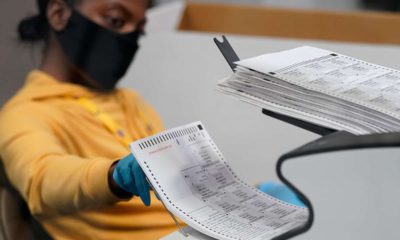Published
5 years agoon
By
CalMatters
Flo Hodes is doing everything she can to avoid post-Election Day BS.
A Democratic voter living in Oakland, she has watched with mounting concern President Donald Trump’s refusal to say whether he will abide by the reported election results, his continued efforts to undermine public confidence in voting by mail, and recent operational changes at the U.S. Postal Service.

Ben Christopher
CalMatters
An estimated 58% of likely voters — Democrats, Republicans and independents — worry that the presidential election results will not be “fair or open,” according to a recent statewide survey out of UC Berkeley.
To counteract any “shenanigans,” Hodes says she is hoping for a victory so overwhelming and immediately apparent that it will be beyond dispute.
“I want it to be just a clear landslide on the night of or the next morning,” she said. A prolonged period of electoral uncertainty after that would allow “for all kinds of bull**** to happen.”
There is no statewide directive dictating the order in which ballots must be counted, said Chris Miller, spokesperson for the California election-regulating secretary of state. But if you want your ballot counted as soon as possible, know that county officials say they’ll mostly be tallied in this order:
“We’re counting ballots right now as we speak,” said Joe Holland, Santa Barbara County registrar. A new law permits officials to process incoming ballots starting Oct. 5.
“Processing” means checking for valid signatures, removing envelopes, sorting and, in some cases, actually feeding ballots into a counting computer. Officials aren’t allowed to peek at those numbers until the polls close, but by 8:01 p.m. on Nov. 3, many counties will be able to deliver the first batch of numbers.
The method of transport doesn’t matter much. Whether a ballot gets to the county by mail, through a drop box or delivered to a vote center, the earlier a ballot arrives, the more likely it will be tabulated first.
At a certain point — likely no earlier than the weekend before Election Day — county officials will have to stop pre-processing in-coming ballots and start prioritizing Election Day planning, responding to the inquiries of panicky voters, handling the onslaught on in-person early voting and addressing various emergencies.
“It’s just about capacity,” said Holland. “If you wait until the last minute, the results of your ballot don’t show up on election night.”
Once the early votes are counted and reported, election officials will turn to ballots cast in-person on Election Day. State law requires county registrars to stay in their office until all of those in-person ballots are counted.
“Four years ago we stayed until 5:30 a.m.,” said Mike Sanchez, a spokesperson for the Los Angeles County Registrar.
Cathy Darling Allen, the Shasta County registrar, said the farthest precinct from her Redding office is a two-hour drive. The night-of count can’t end until those ballots arrive. “We’ve never been done by midnight — we can’t be,” she said.
She is encouraged that nearly 30,000 ballots — from more than a quarter of the county’s electorate — have already poured in.
“They’re listening to our instructions! Which is so great! We love it!” kvelled Allen. “Wow, wow, wow!”
California law makes it as easy for votes to cast a ballot.
But all this does slow down the process.
Counties have to check the provisional ballots against every other vote cast in the state — significant, because it should prevent someone from successfully voting twice. Same-day registration forms have to be processed before those votes are considered. The 17-day law means registrars will have to sit around for more than two weeks in case a few ballots got stuck in transit.
It’s a long, slow process by design. But it’s one designed to ensure that regardless of when or how a ballot is cast, as long as it’s on or before Election Day, it will be counted.
But if timing is everything to you, consider voting early.
About the Author
Via the Post It, CalMatters political reporter Ben Christopher shares frequent updates from the (socially distanced) 2020 campaign trail. Ben covers California politics and elections. Prior to that, he was a contributing writer for CalMatters reporting on the state’s economy and budget.


‘With Reservations’: Trump Voters Grapple With Biden’s Win


Turning the Page? Republicans Acknowledge Biden’s Victory


Walters: California Is No. 1 — in Rough Highways


Trump Thought Courts Were Key to Winning. Judges Disagreed.


Rationales Shift as Nevada Considers Future of Vote by-Mail


Trump Directs Administration to Allow Biden Transition Process




